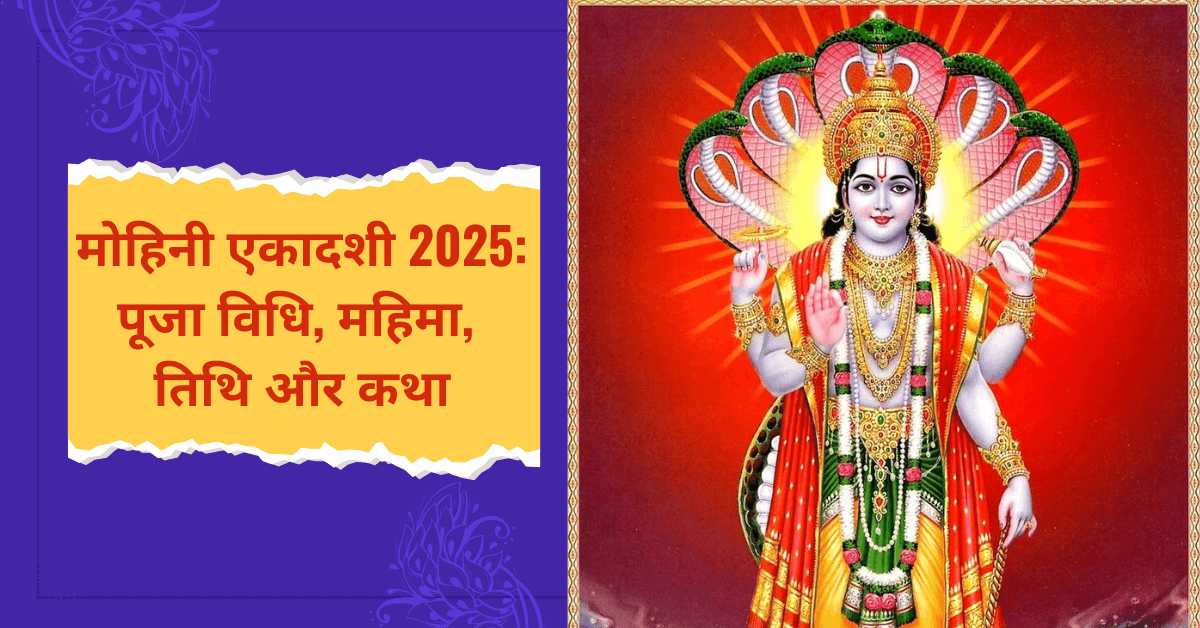In Hinduism, every Ekadashi holds divine significance as a day dedicated to Lord Vishnu. Falling on the eleventh day of each lunar fortnight, Ekadashi is a day of spiritual discipline, fasting, and devotion. Among all 24 Ekadashis observed throughout the year, Mohini Ekadashi is considered one of the most sacred and powerful. This auspicious day falls during the Shukla Paksha (waxing phase of the moon) in the month of Vaishakha, corresponding to April–May in the Gregorian calendar.
In 2025, Mohini Ekadashi will be celebrated on Thursday, 8 May 2025. On this day, devotees worship Lord Vishnu in His enchanting form, Mohini Avatar, who symbolizes the removal of illusion and ignorance. Observing the Mohini Ekadashi fast with devotion is said to destroy all sins, grant prosperity, and lead to liberation (moksha).
Mohini Ekadashi 2025: Date, Time, and Parana
- Ekadashi Date: Thursday, 8 May 2025
- Ekadashi Tithi Begins: 07:02 AM on 7 May 2025
- Ekadashi Tithi Ends: 05:18 AM on 8 May 2025
- Parana (Vrat Breaking) Time: 06:00 AM to 08:35 AM on 9 May 2025
The fast is broken after sunrise on the Dwadashi Tithi, only after offering prayers to Lord Vishnu. Performing Parana at the correct time is vital; breaking the fast too early or too late is considered inauspicious.
The Spiritual Meaning of Mohini Ekadashi
The word “Mohini” means “the enchantress” — referring to the divine female form assumed by Lord Vishnu to protect righteousness. According to scriptures, during the Samudra Manthan (churning of the ocean), gods and demons together churned the ocean to obtain Amrit (nectar of immortality). When the nectar emerged, a fierce dispute arose between the gods (Devas) and demons (Asuras) over its distribution.
To protect the Devas, Lord Vishnu took the captivating form of Mohini, a celestial enchantress, and skillfully distributed the nectar among the gods, deceiving the demons. This act symbolizes the victory of divine wisdom over ignorance and illusion.
Thus, Mohini Ekadashi represents the power of divine grace that removes the darkness of Maya (illusion) and guides devotees toward the light of truth and salvation.
Mohini Ekadashi Vrat Katha (The Legend)
The story of Mohini Ekadashi is described in the Kurma Purana. When King Yudhishthira once asked Lord Krishna about the significance of this sacred day, the Lord narrated an ancient tale:
In the city of Bhadravati, ruled a noble king named Dyutimana, belonging to the Chandravanshi dynasty. Among his subjects lived a sinful man named Dhrishtabuddhi, who led a wicked life filled with gambling, theft, and immorality. His evil deeds caused immense distress to others, and eventually, his father expelled him from the house.
Wandering aimlessly in misery, Dhrishtabuddhi once met Sage Kaundinya on the banks of the sacred river Ganga. Overcome with remorse, he bowed to the sage and sought guidance for redemption. The compassionate sage advised him to observe the Mohini Ekadashi Vrat, dedicating the day entirely to Lord Vishnu.
Following the sage’s advice, Dhrishtabuddhi fasted faithfully on Mohini Ekadashi, spending the day in prayer and meditation. His sins were cleansed, and upon his death, he attained Vaikuntha, the divine abode of Lord Vishnu.
Lord Krishna concluded by saying that anyone who observes this fast with devotion will be freed from all sins and attain eternal bliss.
Mohini Ekadashi Vrat Vidhi (Rituals and Puja Method)
1. Preparation (Ekadashi Eve)
On the day before Ekadashi, devotees eat a light, sattvic meal before sunset and avoid consuming grains or beans. This prepares the body and mind for fasting and spiritual discipline.
2. Early Morning Bath and Sankalp
On the morning of Mohini Ekadashi, devotees wake up during Brahma Muhurat (before sunrise), take a holy bath, and wear clean, modest clothes. Facing the deity, they take a Sankalp (vow) to observe the fast with devotion, seeking forgiveness for past mistakes and blessings for a pure heart.
3. Worship and Offerings
- Place an idol or image of Lord Vishnu on a clean altar.
- Offer Tulsi leaves, yellow flowers, incense, sandalwood paste, fruits, and lamps (diyas).
- Chant the Vishnu Sahasranama or recite Vishnu Chalisa.
- Offer sweets or fruits as Naivedya and perform Aarti with devotion.
4. The Fast (Vrat)
Devotees observe either:
- Nirjala Ekadashi (Without food or water) — the most austere and rewarding form.
- Phalahar Vrat (Only fruits, milk, and water) — suitable for those who cannot go completely without food.
Throughout the day, devotees avoid rice, grains, garlic, onion, and tamasic foods. The focus remains on chanting Vishnu’s name, reading scriptures, and meditating on divine qualities.
5. Jagaran (Night Vigil)
In many temples, devotees stay awake all night singing devotional hymns and performing Vishnu Kirtan. Staying awake symbolizes alertness of the soul and detachment from worldly sleep or ignorance.
6. Parana (Breaking the Fast)
The next morning (Dwadashi), devotees offer food to Brahmins or the poor before breaking their fast. Only after completing these rituals should they consume food themselves.
Dos and Don’ts During Mohini Ekadashi
Dos
- Wake up before sunrise and begin the day with prayer.
- Keep the body and mind pure; avoid anger, lies, and harmful actions.
- Chant “Om Namo Bhagavate Vasudevaya” or “Vishnave Namah” throughout the day.
- Engage in reading scriptures like the Bhagavad Gita and Vishnu Purana.
- Perform charity by donating food, clothes, or money to the needy.
Don’ts
- Do not eat rice, grains, pulses, or non-vegetarian food.
- Avoid alcohol, tobacco, and any form of indulgence.
- Do not harm or disrespect anyone.
- Avoid sleeping during the day or engaging in gossip.
Benefits of Observing Mohini Ekadashi
Observing Mohini Ekadashi brings numerous spiritual, emotional, and physical benefits:
Spiritual Benefits
- Removes all forms of sin and negative karma.
- Purifies the soul and strengthens devotion toward Lord Vishnu.
- Brings peace, happiness, and prosperity to the devotee’s life.
- Grants liberation (moksha) from the cycle of birth and death.
Physical and Mental Benefits
- Fasting allows the body to detoxify and reset digestion.
- Enhances focus, concentration, and inner calm.
- Promotes discipline, self-control, and emotional balance.
The alignment of fasting with lunar energy also helps maintain body rhythm and spiritual harmony.
Mohini Ekadashi Celebrations in India
In North India
Temples such as Dwarkadhish (Mathura), Banke Bihari (Vrindavan), and Jagannath Puri are beautifully decorated. Devotees perform Tulsi Archana and participate in bhajans and aartis throughout the night.
In South India
At famous temples like Tirupati Balaji, Srirangam, and Udupi Krishna Mandir, the day is marked with Abhishekam, Tirumanjanam, and distribution of prasadam. Devotees offer garlands, lamps, and flowers to Vishnu idols while reciting Vedic hymns.
In Maharashtra and Gujarat
People observe fasts at home, conduct Vishnu puja, and light diyas in front of the Tulsi plant in the evening. Many devotees read the Mohini Ekadashi Vrat Katha with their families.
Charity and Seva
Performing charity on Mohini Ekadashi is said to bring divine blessings manifold. Donating food, clothes, or helping the needy enhances the fruit of the fast. Feeding cows, birds, or offering water to travelers is also highly auspicious.
Scriptures emphasize that the daan (charity) done on Mohini Ekadashi purifies the heart and pleases Lord Vishnu immensely.
Mantras and Bhajans for the Day
Main Mantra:
“Om Namo Bhagavate Vasudevaya”
Chanting this mantra repeatedly connects the devotee with the divine energy of Lord Vishnu and purifies the soul.
Bhajan Suggestions:
- “Vishnu Sahasranama Stotra”
- “Govindam Adi Purusham”
- “Om Jai Jagdish Hare”
Listening to or singing these devotional songs fills the heart with peace and spiritual joy.
Mohini Ekadashi in Hindu Scriptures
The greatness of Mohini Ekadashi is mentioned in various Puranas including:
- Kurma Purana
- Padma Purana
- Bhavishya Purana
Each of these texts emphasizes that fasting on Mohini Ekadashi cleanses all sins and grants one a place in Vaikuntha, the divine abode of Lord Vishnu.
Modern Relevance of Mohini Ekadashi
In today’s busy world, observing Mohini Ekadashi helps bring spiritual focus and calm. It reminds devotees to detach from material illusions and realign with spiritual truth. The discipline of fasting cultivates patience, self-awareness, and mindfulness—qualities often lost in modern life.
Even if one cannot observe a strict fast, dedicating the day to prayer, charity, and compassion brings similar blessings. Mohini Ekadashi teaches that the essence of life lies not in indulgence but in devotion, truth, and purity.
Conclusion
Mohini Ekadashi 2025, observed on Thursday, 8 May, is not merely a ritual but a journey toward inner awakening. Through fasting, prayer, and devotion, one transcends worldly illusions and experiences divine peace.
As Lord Krishna told Yudhishthira, “The one who observes Mohini Ekadashi with faith is freed from all sins, attains peace in this life, and reaches My divine abode after death.”
Let us, therefore, celebrate Mohini Ekadashi 2025 with devotion, purity, and gratitude—lighting lamps of faith that dispel the darkness of illusion and bring the light of Vishnu’s grace into our lives.
FAQs on Mohini Ekadashi 2025
1. When is Mohini Ekadashi in 2025?
Mohini Ekadashi in 2025 will be observed on Thursday, 8 May 2025. The Ekadashi Tithi begins on 7 May at 07:02 AM and ends on 8 May at 05:18 AM. Devotees will break their fast (Parana) on 9 May between 06:00 AM and 08:35 AM.
2. What is the significance of Mohini Ekadashi?
Mohini Ekadashi is one of the most auspicious days dedicated to Lord Vishnu. It is believed that observing this fast removes all sins, grants peace and prosperity, and helps devotees attain Moksha (liberation). The fast also symbolizes freedom from illusion (Maya).
3. Why is it called Mohini Ekadashi?
The name “Mohini” comes from the divine form of Lord Vishnu, who took the Mohini avatar to distribute Amrit (nectar of immortality) among the gods during the Samudra Manthan. Hence, this Ekadashi represents the victory of divine wisdom over illusion and temptation.
4. What should we eat on Mohini Ekadashi?
Devotees usually avoid rice, grains, pulses, and onion-garlic. Instead, they consume fruits, milk, curd, nuts, sabudana, and vrat-friendly foods. Some observe a Nirjala fast (without food or water) for complete devotion.
5. What are the benefits of observing Mohini Ekadashi Vrat?
Observing this fast brings spiritual purification, peace of mind, and prosperity. It helps devotees overcome negative karma, strengthens faith in Lord Vishnu, and leads toward salvation.
6. Can anyone observe Mohini Ekadashi fast?
Yes, both men and women can observe this fast. It is especially beneficial for those seeking spiritual growth, forgiveness of sins, and blessings of Lord Vishnu.
Krishna Mishra writes for Insights of Hinduism, where he shares heartfelt thoughts on festivals, traditions, and the timeless wisdom of Sanatan Dharma. His aim is to keep the essence of Hindu culture alive in a way that feels simple, authentic, and relatable to everyone.


